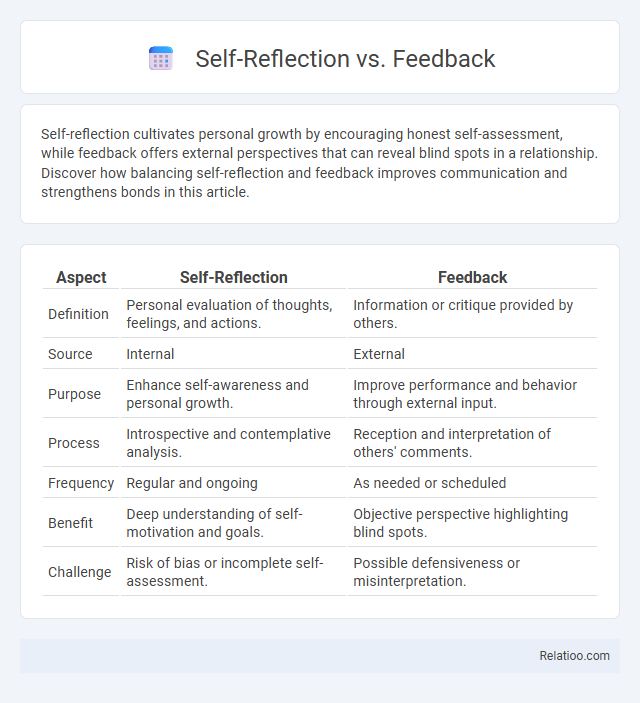Self-reflection cultivates personal growth by encouraging honest self-assessment, while feedback offers external perspectives that can reveal blind spots in a relationship. Discover how balancing self-reflection and feedback improves communication and strengthens bonds in this article.
Table of Comparison
| Aspect | Self-Reflection | Feedback |
|---|---|---|
| Definition | Personal evaluation of thoughts, feelings, and actions. | Information or critique provided by others. |
| Source | Internal | External |
| Purpose | Enhance self-awareness and personal growth. | Improve performance and behavior through external input. |
| Process | Introspective and contemplative analysis. | Reception and interpretation of others' comments. |
| Frequency | Regular and ongoing | As needed or scheduled |
| Benefit | Deep understanding of self-motivation and goals. | Objective perspective highlighting blind spots. |
| Challenge | Risk of bias or incomplete self-assessment. | Possible defensiveness or misinterpretation. |
Understanding Self-Reflection: Definition and Importance
Self-reflection involves introspecting on personal experiences, thoughts, and emotions to gain deeper self-awareness, which is crucial for personal growth and emotional intelligence. Feedback, typically received from others, provides external perspectives that can highlight blind spots and areas for improvement beyond one's introspection. Understanding self-reflection is essential because it empowers individuals to critically evaluate their behaviors and decisions, fostering continuous learning and enhanced mental well-being.
The Role of Feedback in Personal and Professional Growth
Feedback plays a crucial role in personal and professional growth by providing external perspectives that challenge self-reflection biases and uncover blind spots. While self-reflection enables individuals to analyze their thoughts and actions internally, feedback offers objective insights that can lead to actionable improvements and skill development. Integrating feedback with self-reflection enhances self-awareness, promotes continuous learning, and drives meaningful behavioral change.
Key Differences Between Self-Reflection and Feedback
Self-reflection involves internal evaluation of one's thoughts, emotions, and actions, fostering personal insight and growth through introspection. Feedback, by contrast, is external input from others providing specific observations or assessments aimed at improving performance or behavior. Key differences include self-reflection's subjective and autonomous nature versus feedback's objective, communicative process requiring interpersonal interaction.
Benefits of Practicing Self-Reflection
Practicing self-reflection enhances personal growth by fostering deeper self-awareness and emotional intelligence, which feedback alone may not fully develop. Unlike external feedback, self-reflection encourages critical thinking and helps identify intrinsic motivations and areas for improvement from an internal perspective. Regular self-reflection improves decision-making, resilience, and goal alignment, leading to sustained professional and personal development.
Advantages of Seeking and Receiving Feedback
Seeking and receiving feedback enhances self-awareness by providing external perspectives that highlight blind spots and areas for improvement. Unlike self-reflection alone, feedback offers concrete insights from others that can validate strengths and identify weaknesses more accurately. Incorporating feedback accelerates personal and professional growth by fostering continuous learning and adaptation based on real-world observations.
Common Challenges: Self-Reflection vs Feedback
Common challenges in self-reflection versus feedback involve overcoming personal biases and emotional barriers that can distort self-assessment, whereas feedback often faces issues related to clarity, delivery, and acceptance by the receiver. You may struggle with accurately identifying areas for improvement on your own, while external feedback might be hindered by miscommunication or resistance to critique. Balancing both self-reflection and feedback effectively requires developing open-mindedness and critical thinking to maximize personal growth and performance enhancement.
When to Rely on Self-Reflection vs Feedback
Rely on self-reflection when aiming to deepen personal insight and evaluate internal motivations or emotions without external bias. Feedback is more effective for gaining objective perspectives on performance, behavior, or skills from others' experiences and observations. Combine both approaches for comprehensive growth, using self-reflection to internalize lessons and feedback to identify blind spots.
Integrating Self-Reflection and Feedback for Maximum Growth
Integrating self-reflection and feedback enhances personal growth by combining internal insights with external perspectives, allowing you to identify blind spots and reinforce strengths effectively. Self-reflection helps you analyze your thoughts and behaviors, while feedback offers objective evaluations from others, creating a comprehensive framework for continuous improvement. Prioritizing both processes fosters a growth mindset, accelerating skill development and improving decision-making.
Practical Tips for Effective Self-Reflection
Effective self-reflection involves setting aside dedicated time to honestly evaluate your actions, thoughts, and emotions, enabling personal growth. Incorporate journaling your experiences and lessons learned to track progress, while avoiding harsh self-criticism to maintain motivation. You can enhance self-reflection by combining it with feedback from others, using objective insights to refine your self-assessment and improve outcomes.
How to Solicit and Utilize Constructive Feedback
To solicit constructive feedback effectively, create a safe and open environment that encourages honesty and specificity from colleagues or mentors. Utilize specific questions targeting areas of improvement and request examples to gain actionable insights. Combine this feedback with self-reflection by comparing external perspectives with personal evaluations to develop targeted growth strategies and measure progress over time.

Infographic: Self-reflection vs Feedback
 relatioo.com
relatioo.com